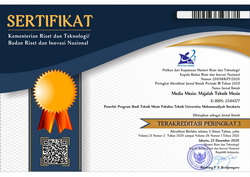THE INVESTIGATION OF VOID FRACTION OF TWO-PHASE FLOW AIR-WATER AND GLYCERINE (0-30%) IN THE CAPILLARY PIPE WITH SLOPE OF 50 TO HORIZONTAL POSITION
S Sukamta(1*), Aldi Rahadian Ilham(2), S Sudarja(3)(1) Universitas Muhammadiyah Yogyakarta
(2) Universitas Muhammadiyah Yogyakarta
(3) Universitas Muhammadiyah Yogyakarta
(*) Corresponding Author
Abstract
Two-phase flow is a flow that is composed of two combined substances, i.e., liquid and gas. Two-phase flow phenomena can be a lot encountered in nature, for example, exhaust gas smoke, fog, rain, cloud, snow, and so forth. Moreover, in the practice of company or industry environment, the flow of the two phases can be encountered on the equipment in the form of heat exchangers, boilers, nuclear reactors, piping systems, geothermal, natural gas liquefaction, and others. Data collection in this research was carried out in 4 stages (from working fluid), namely: air-water, air-water+0% glycerin, air-water+10% glycerin, air-water+20% glycerin, and air-water+30% glycerin. The research aims to determine the void fraction by using the method of digital image processing with the software MATLAB R2014a. Based on the research results, it was obtained that when superficial gas velocity high then, the value of the void fraction obtained will increase, otherwise the higher speed of the superficial liquid then, the value of void fraction that is retrieved will decrease. The viscosity of the fluid very influenced the flow pattern bubbly and plug. It is because the higher the viscosity of fluid flow pattern speed then, the bubbly and the plug will increasingly decline, instead of getting down viscosity makes bubbly flow pattern speed, and the plug will progressively increase. The length of the bubbly and plug pattern is affected by the increasing value of homogeneous (β). As a consequence, the length of the pattern increases. In the frequency when the bubbly and plug occurred, it was obtained a high enough rate that led to the value of the void fraction generated considerable increases.
Keyword: two-phase, fluid, void fraction, viscosity, flow pattern.
Full Text:
PDFReferences
Ali, M.I., Sadatomi, M., Kawaji, M., 1993. Two-phase flow in narrow channels between two flat plates. Can. J. Chem. Eng., Vol. 71, pp. 657–666.
Biksono, Damawidjaya. 2006.“Karakteristik dan Visualisasi Aliran Dua Fasa Pada Pipa Spiral”. Jurnal Teknik Mesin, Universitas Kristen Petra. 8(2): 69-74.
Chung, P.M.-Y., Kawaji, M., 2004. The Effect of Channel Diameter on Adiabatic Two-Phase Flow Characteristics in The Microchannel. Int. J. Multiphase Flow, Vol. 30, pp. 735-761.
Fukano, T., Kariyasaki, A., 1993, Characteristic of Gas-Liquid Two-Phase Flow in a Capillary Tube, Nuclear Engineering and Design, Vol. 141, pp. 59-68.
Kawahara, A., Chung, P.M.Y., Kawaji, M., 2002, Investigation of Two-Phase Flow Pattern, Void Fraction and Pressure Drop in a Microchannel, International Journal of Multiphase Flow, Vol. 28, pp. 1411-1435.
Mayor, T.S., Pinto, A.M.F.R., Campos, J.B.L.M., 2007, An Image Analysis Technique for The Study of Gas-Liquid Slug Flow along Vertical Pipes – Associated Uncertainty, Flow Measurement and Instrumentation, Vol 18, pp. 139-147.
Montoya, G.A., Deendarlianto, Lucas, D., Hohne, T., Vallee, C., 2012. Image Processing Based Study of Interfacial Behavior of the Countercurrent Gas-Liquid Two-Phase Flow in Hot Leg of a PWR. Science and Technology of Nuclear Installations, Vol. 2012, pp. 1-10.
Sudarja, Deendarlianto, Indarto, Haq. A., 2015, Experimental study on the void fraction of air-water two-phase flow in a horizontal circular mini-channel
Triplett K.A., Ghiaasiaan, S.M., Abdel-Khalik, S.I., Sadowski, D.I., 1999, Gas-Liquid Two-Phase Flow in Microchannels Part II: void fraction and pressure drop, International Journal of Multiphase Flow, Vol. 25, pp. 395-410.
Wallis, G. B., 1969, One-Dimensional Two-Phase Flow, McGraw-Hill, New York.
Article Metrics
Abstract view(s): 911 time(s)PDF: 538 time(s)
Refbacks
- There are currently no refbacks.








